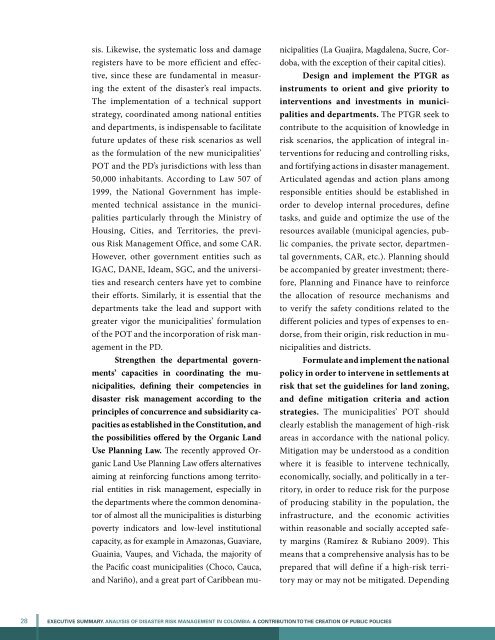Executive Summary - GFDRR
Executive Summary - GFDRR
Executive Summary - GFDRR
Create successful ePaper yourself
Turn your PDF publications into a flip-book with our unique Google optimized e-Paper software.
sis. Likewise, the systematic loss and damage<br />
registers have to be more efficient and effective,<br />
since these are fundamental in measuring<br />
the extent of the disaster’s real impacts.<br />
The implementation of a technical support<br />
strategy, coordinated among national entities<br />
and departments, is indispensable to facilitate<br />
future updates of these risk scenarios as well<br />
as the formulation of the new municipalities’<br />
POT and the PD’s jurisdictions with less than<br />
50,000 inhabitants. According to Law 507 of<br />
1999, the National Government has implemented<br />
technical assistance in the municipalities<br />
particularly through the Ministry of<br />
Housing, Cities, and Territories, the previous<br />
Risk Management Office, and some CAR.<br />
However, other government entities such as<br />
IGAC, DANE, Ideam, SGC, and the universities<br />
and research centers have yet to combine<br />
their efforts. Similarly, it is essential that the<br />
departments take the lead and support with<br />
greater vigor the municipalities’ formulation<br />
of the POT and the incorporation of risk management<br />
in the PD.<br />
Strengthen the departmental governments’<br />
capacities in coordinating the municipalities,<br />
defining their competencies in<br />
disaster risk management according to the<br />
principles of concurrence and subsidiarity capacities<br />
as established in the Constitution, and<br />
the possibilities offered by the Organic Land<br />
Use Planning Law. The recently approved Organic<br />
Land Use Planning Law offers alternatives<br />
aiming at reinforcing functions among territorial<br />
entities in risk management, especially in<br />
the departments where the common denominator<br />
of almost all the municipalities is disturbing<br />
poverty indicators and low-level institutional<br />
capacity, as for example in Amazonas, Guaviare,<br />
Guainia, Vaupes, and Vichada, the majority of<br />
the Pacific coast municipalities (Choco, Cauca,<br />
and Nariño), and a great part of Caribbean municipalities<br />
(La Guajira, Magdalena, Sucre, Cordoba,<br />
with the exception of their capital cities).<br />
Design and implement the PTGR as<br />
instruments to orient and give priority to<br />
interventions and investments in municipalities<br />
and departments. The PTGR seek to<br />
contribute to the acquisition of knowledge in<br />
risk scenarios, the application of integral interventions<br />
for reducing and controlling risks,<br />
and fortifying actions in disaster management.<br />
Articulated agendas and action plans among<br />
responsible entities should be established in<br />
order to develop internal procedures, define<br />
tasks, and guide and optimize the use of the<br />
resources available (municipal agencies, public<br />
companies, the private sector, departmental<br />
governments, CAR, etc.). Planning should<br />
be accompanied by greater investment; therefore,<br />
Planning and Finance have to reinforce<br />
the allocation of resource mechanisms and<br />
to verify the safety conditions related to the<br />
different policies and types of expenses to endorse,<br />
from their origin, risk reduction in municipalities<br />
and districts.<br />
Formulate and implement the national<br />
policy in order to intervene in settlements at<br />
risk that set the guidelines for land zoning,<br />
and define mitigation criteria and action<br />
strategies. The municipalities’ POT should<br />
clearly establish the management of high-risk<br />
areas in accordance with the national policy.<br />
Mitigation may be understood as a condition<br />
where it is feasible to intervene technically,<br />
economically, socially, and politically in a territory,<br />
in order to reduce risk for the purpose<br />
of producing stability in the population, the<br />
infrastructure, and the economic activities<br />
within reasonable and socially accepted safety<br />
margins (Ramírez & Rubiano 2009). This<br />
means that a comprehensive analysis has to be<br />
prepared that will define if a high-risk territory<br />
may or may not be mitigated. Depending<br />
28 EXECUTIVE SUMMARY. ANALYSIS OF DISASTER RISK MANAGEMENT IN COLOMBIA: A contribution TO the creation of public policies

















